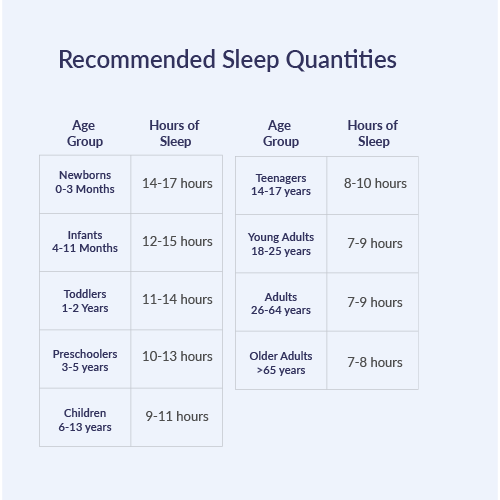
While you’d be hard pressed to find someone who doesn’t spend most of their life sleeping, there aren’t that many people that know the basics of sleep. Someone equipped with those basics, though, is able to understand why sleep is critical to recovery, and even why it could be considered the most important variable in any fitness journey.
In this article, we’ll cover the structure of sleep, and what variables you need to worry about if you want to get the very most out of your nightly rest and recovery. We’ll even cover what to do if you fall behind on sleep!
Welcome to our article on the basics of sleep!
Table of Contents
The Stages of Sleep

First, we’ll break down the stages of a good night’s sleep. Understanding these stages should help you understand why sleep is so important, and help you optimize your sleep patterns.
Sleep Stage 1: N1
When you first fall asleep, you enter NREM (Non-Rapid Eye Movement) sleep. Research has revealed NREM consists of three stages, the first stage being N1.
N1 is the transitional stage between being awake and falling asleep, also known as light sleep, and is marked by both mental and physical relaxation. Studies have also shown that this stage is sometimes accompanied by a feeling of falling, causing you to suddenly wake up.
In essence, N1 is the gateway to the deeper stages of sleep.
Sleep Stage 2: N2
N2 is the onset of sleep, during which you become disengaged from your surroundings.
When you reach this stage of sleep, your body temperature drops, your heart rate slows, your breathing becomes more regular, and your muscles relax completely. N2 is your first step into complete rest, and the entryway into N3, which is crucial to physical recovery.
Sleep Stage 3: N3
N3 is the stage of deep, restorative sleep. During this stage, your blood pressure drops, your breathing slows, and blood flow to muscles increases.
During this stage of NREM, your tissue and muscle repairs themselves. For this reason, N3 is paramount to muscle growth.
Hormones such as growth hormone are released and regulated during this stage, as well as hormones that contribute to muscle growth, muscle retention, fat loss, fat storage, and recovery.
Lastly, N3 boosts immune function in your body, keeping your guard up against colds, flus, and other attacks on your immune system.
Has your muscle growth stalled despite a proper fitness and nutrition regimen? The "common cold" becoming a little too common? You might be in sore need of some N3 sleep.
After N3, you'll briefly re-enter sleep stages N2 and N1 before entering into the ultimate sleep stage: REM sleep.
Sleep stage 4: REM Sleep
REM (Rapid Eye Movement) sleep provides energy to the brain and body, supports daytime performance and alertness, consolidates long term memory, and solidifies new muscle memory.
You will enter REM sleep about 90 minutes after falling asleep.
During this time, your muscles completely relax and your eyes dart back and forth (hence the name). Without proper REM sleep, you'll find yourself sluggish throughout the day, slow to the take, and you won't fully solidify any new skills or information you take in throughout the day, physically or mentally.
Does the idea of going to the gym sound like nails on a chalkboard? Is the couch constantly calling your name? Lack of REM sleep may be the culprit.
Following REM Sleep, you'll reenter N1 and head into the next sleep cycle. On a good night’s rest, you repeat the cycle 4-5 times (Fig 1).
The Macro Variables of Sleep
With an understanding of the different benefits of the stages of sleep, the next step is figuring what variables are most important when it comes to getting optimal rest.
There are three important variables, or the "macro variables" when it comes to proper sleep habits: quantity, consistency, and continuity.
Quantity

Fig. A
The first macro variable of sleep is quantity, or getting enough hours of sleep you get on a nightly basis. Studies show most adults need 7-9 hours of sleep a night to be "well rested". Another good general rule is you need a minimum of an hour of sleep for every 2 hours that you're awake. Research supports this 2:1 sleep to awake ratio.
It is important to note that this optimal quantity can vary between different age groups. Fortunately, the National Sleep Foundation has constructed a chart that breaks down optimal sleep quantity by age group, which we've replicated here in the post (Fig. A).
So how do you know for sure that you are getting enough rest? There are a few telltale signs.
- With adequate sleep quantity, you should be able to wake up without an alarm clock.
- Further, you should feel alert throughout the day. Bouts of drowsiness throughout the day let you know that you should have spent more time catching ZZZ's!
Lastly, it's important to note that if you are acclimating to a new sleep schedule or just recovering sleep debt, you may need higher than the average amount of sleep for your age group. Once acclimated, however, you might actually end up needing less sleep than average!
Consistency
The second macro variable of sleep is consistency or making sure you go to bed and wake up at the same time every day. Studies show that a consistent sleep schedule translates to higher quality sleep.
A consistent sleep schedule will ensure the stabilization of your body's internal clock and translates to more restful sleep at night as well as more alert wakefulness during the day.
A consistent sleep schedule will also mean you'll have an easier time getting to bed, and an easier time getting up in the morning. Studies also have shown that a consistent sleep schedule can also leave you needing to spend less time asleep since the time you spend sleeping is higher quality.
If you make sure you go to bed and wake up at the same time every day, you will benefit from the advantages of a consistent sleep schedule. The occasional late night or early morning won't do too much damage, so long as you stick to a consistent sleep schedule the majority of the time.
Continuity
The last macro variable of sleep is continuity or making sure you sleep in one continuous block throughout the night. Sleeping in one continuous block is critical for making sure your night's rest is high quality.
So what happens if you don't sleep in one continuous block? Studies show interrupted sleep disrupts your sleep cycle, and makes your sleep less efficient. Research has also shown that those who slept in one continuous block felt they needed to spend fewer hours in bed than those whose sleep was interrupted. One continuous block of sleep saves you time and the struggle of fatigue throughout the day!
Frequently Asked Questions
Here are some of the most frequently asked questions about sleep!
What Do I Do If I Fall Behind on Sleep?
There is no getting around sleep debt. If you lose sleep one night, your body will need to make up for it at some point, and until you do you’ll suffer the disadvantages of sleep deprivation.
To recover this debt, it is best to make up for lost sleep gradually over a number of days, as opposed to all in one night.
If you sleep in several hours later than usual in the morning, you'll find it harder to get to sleep that night, and a vicious cycle begins.
Gradual reduction of sleep debt ensures the least disturbance to your biological clock, which should be your first priority.
Steady progress in working through sleeplessness is the best way to sleep better. Grab an extra hour here and there, either before your usual bedtime or in the morning.
The Afternoon Nap: The Secret Weapon to Optimal Rest

Napping can also be a great strategy to make up your sleep debt (especially if you can't sleep at night).
For a quick boost in energy, mood, and performance, a 20-minute nap has been shown to be effective. A 20-minute nap allows for the first two stages of sleep without slipping into N3 (deep sleep) and waking up groggy and drowsy.
If you have the time, a longer 90-minute nap can also be beneficial and help you recoup a cycle of N3 and REM sleep. 90 minutes is just enough time to cycle through all the stages of sleep once and arrive at the N2 stage without feeling groggy.
It is important to note that you should avoid taking a long nap late in the day, as this can make it difficult to get to sleep that night.
Pro tip to help you fall asleep for a nap: Aim to take your longer naps in the early afternoon after lunch when your blood sugar is dropping naturally. This will make it easier to fall asleep, and have minimal interference with your bedtime later that day.
Conclusion
That concludes our article on the basics of sleep. In this article, we covered:
- Every night's sleep is made of several sleep cycles, and each cycle is divided into stages.
- You go through all the stages in 90 minutes, and you want to maximize the amount of 90 minute cycles you get every night to maximize the benefits of sleep.
- To get the most out of your sleep, you want to spend enough time sleeping, make sure it's the same time every day, and make sure your sleep is uninterrupted.
- If you need to catch up on sleep, an afternoon nap is a great way to do so without disrupting your sleep schedule.
With this information in mind, you should be equipped with everything you need to get the most out of every night’s rest. If you’re wondering how sleep directly relates to muscle growth or fat loss, check out our articles on Sleep and Muscle Growth as well as Sleep and Fat Loss!
References and Useful Research
- Aserinsky E, Kleitman N. Regularly occurring periods of eye motility, and concomitant phenomena, during sleep.
Science. 1953;118:273-274 Link - Rechtschaffen A. Current perspectives on the function of sleep. Perspectives in Biology and Medicine.
1998;41:359-390. Link - National Sleep Foundation, The Sleep-Wake Cycle: Its Physiology and Impact on Health, Arlington: NSF, 2006. Available at: https://sleepfoundation.org/how-sleep-works/what-happens-when-you-sleep Link
- Maas, James B., et al. Sleep for Success: Everything You Must Know About Sleep but Are Too Tired to Ask. Author House, 2011. Link
- Hirshkowitz M, Whiton K, Albert SM, et al. National Sleep Foundation’s sleep time duration recommendations: methodology and results summary. Sleep Health: Journal of the National Sleep Foundation. 2015;1(1):40-43. doi:10.1016/j.sleh.2014.12.010 link
- Maas, James B., et al. Sleep for Success: Everything You Must Know about Sleep but Are Too Tired to Ask. Author House, 2011.
- Manber R, Bootzin RR, Acebo C, Carskadon MA. The effects of regularizing sleep-wake schedules on daytime sleepiness. Sleep. 1996;19(5):432-41. link
- Kang JH, Chen SC. Effects of an irregular bedtime schedule on sleep quality, daytime sleepiness, and fatigue among university students in Taiwan. BMC Public Health. 2009;9:248. link
- Finley, Christy L., and Brian J. Cowley. “The Effects of a Consistent Sleep Schedule on Time Taken to Achieve Sleep.” Clinical Case Studies, vol. 4, no. 3, 2005, pp. 304–311., doi:10.1177/1534650103259743. link
- Finan PH, Quartana PJ, Smith MT. The Effects of Sleep Continuity Disruption on Positive Mood and Sleep Architecture in Healthy Adults. Sleep. 2015;38(11):1735-42. link